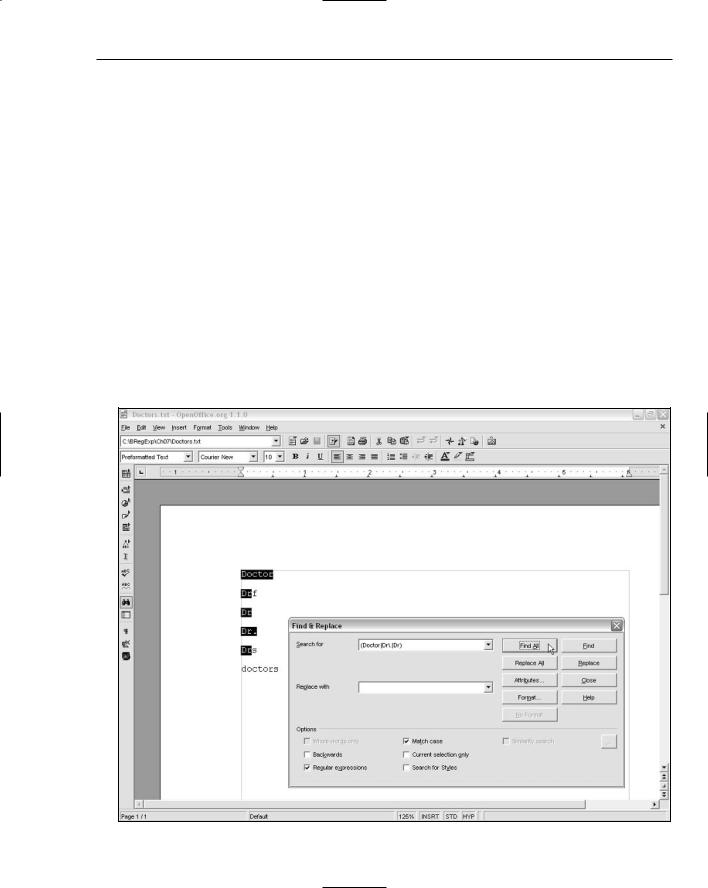
- •Introduction
- •Who This Book Is For
- •What This Book Covers
- •How This Book Is Structured
- •What You Need to Use This Book
- •Conventions
- •Source Code
- •Errata
- •p2p.wrox.com
- •What Are Regular Expressions?
- •What Can Regular Expressions Be Used For?
- •Finding Doubled Words
- •Checking Input from Web Forms
- •Changing Date Formats
- •Finding Incorrect Case
- •Adding Links to URLs
- •Regular Expressions You Already Use
- •Search and Replace in Word Processors
- •Directory Listings
- •Online Searching
- •Why Regular Expressions Seem Intimidating
- •Compact, Cryptic Syntax
- •Whitespace Can Significantly Alter the Meaning
- •No Standards Body
- •Differences between Implementations
- •Characters Change Meaning in Different Contexts
- •Regular Expressions Can Be Case Sensitive
- •Case-Sensitive and Case-Insensitive Matching
- •Case and Metacharacters
- •Continual Evolution in Techniques Supported
- •Multiple Solutions for a Single Problem
- •What You Want to Do with a Regular Expression
- •Replacing Text in Quantity
- •Regular Expression Tools
- •findstr
- •Microsoft Word
- •StarOffice Writer/OpenOffice.org Writer
- •Komodo Rx Package
- •PowerGrep
- •Microsoft Excel
- •JavaScript and JScript
- •VBScript
- •Visual Basic.NET
- •Java
- •Perl
- •MySQL
- •SQL Server 2000
- •W3C XML Schema
- •An Analytical Approach to Using Regular Expressions
- •Express and Document What You Want to Do in English
- •Consider the Regular Expression Options Available
- •Consider Sensitivity and Specificity
- •Create Appropriate Regular Expressions
- •Document All but Simple Regular Expressions
- •Document What You Expect the Regular Expression to Do
- •Document What You Want to Match
- •Test the Results of a Regular Expression
- •Matching Single Characters
- •Matching Sequences of Characters That Each Occur Once
- •Introducing Metacharacters
- •Matching Sequences of Different Characters
- •Matching Optional Characters
- •Matching Multiple Optional Characters
- •Other Cardinality Operators
- •The * Quantifier
- •The + Quantifier
- •The Curly-Brace Syntax
- •The {n} Syntax
- •The {n,m} Syntax
- •Exercises
- •Regular Expression Metacharacters
- •Thinking about Characters and Positions
- •The Period (.) Metacharacter
- •Matching Variably Structured Part Numbers
- •Matching a Literal Period
- •The \w Metacharacter
- •The \W Metacharacter
- •Digits and Nondigits
- •The \d Metacharacter
- •Canadian Postal Code Example
- •The \D Metacharacter
- •Alternatives to \d and \D
- •The \s Metacharacter
- •Handling Optional Whitespace
- •The \S Metacharacter
- •The \t Metacharacter
- •The \n Metacharacter
- •Escaped Characters
- •Finding the Backslash
- •Modifiers
- •Global Search
- •Case-Insensitive Search
- •Exercises
- •Introduction to Character Classes
- •Choice between Two Characters
- •Using Quantifiers with Character Classes
- •Using the \b Metacharacter in Character Classes
- •Selecting Literal Square Brackets
- •Using Ranges in Character Classes
- •Alphabetic Ranges
- •Use [A-z] With Care
- •Digit Ranges in Character Classes
- •Hexadecimal Numbers
- •IP Addresses
- •Reverse Ranges in Character Classes
- •A Potential Range Trap
- •Finding HTML Heading Elements
- •Metacharacter Meaning within Character Classes
- •The ^ metacharacter
- •How to Use the - Metacharacter
- •Negated Character Classes
- •Combining Positive and Negative Character Classes
- •POSIX Character Classes
- •The [:alnum:] Character Class
- •Exercises
- •String, Line, and Word Boundaries
- •The ^ Metacharacter
- •The ^ Metacharacter and Multiline Mode
- •The $ Metacharacter
- •The $ Metacharacter in Multiline Mode
- •Using the ^ and $ Metacharacters Together
- •Matching Blank Lines
- •Working with Dollar Amounts
- •Revisiting the IP Address Example
- •What Is a Word?
- •Identifying Word Boundaries
- •The \< Syntax
- •The \>Syntax
- •The \b Syntax
- •The \B Metacharacter
- •Less-Common Word-Boundary Metacharacters
- •Exercises
- •Grouping Using Parentheses
- •Parentheses and Quantifiers
- •Matching Literal Parentheses
- •U.S. Telephone Number Example
- •Alternation
- •Choosing among Multiple Options
- •Unexpected Alternation Behavior
- •Capturing Parentheses
- •Numbering of Captured Groups
- •Numbering When Using Nested Parentheses
- •Named Groups
- •Non-Capturing Parentheses
- •Back References
- •Exercises
- •Why You Need Lookahead and Lookbehind
- •The (? metacharacters
- •Lookahead
- •Positive Lookahead
- •Negative Lookahead
- •Positive Lookahead Examples
- •Positive Lookahead in the Same Document
- •Inserting an Apostrophe
- •Lookbehind
- •Positive Lookbehind
- •Negative Lookbehind
- •How to Match Positions
- •Adding Commas to Large Numbers
- •Exercises
- •What Are Sensitivity and Specificity?
- •Extreme Sensitivity, Awful Specificity
- •Email Addresses Example
- •Replacing Hyphens Example
- •The Sensitivity/Specificity Trade-Off
- •Sensitivity, Specificity, and Positional Characters
- •Sensitivity, Specificity, and Modes
- •Sensitivity, Specificity, and Lookahead and Lookbehind
- •How Much Should the Regular Expressions Do?
- •Abbreviations
- •Characters from Other Languages
- •Names
- •Sensitivity and How to Achieve It
- •Specificity and How to Maximize It
- •Exercises
- •Documenting Regular Expressions
- •Document the Problem Definition
- •Add Comments to Your Code
- •Making Use of Extended Mode
- •Know Your Data
- •Abbreviations
- •Proper Names
- •Incorrect Spelling
- •Creating Test Cases
- •Debugging Regular Expressions
- •Treacherous Whitespace
- •Backslashes Causing Problems
- •Considering Other Causes
- •The User Interface
- •Metacharacters Available
- •Quantifiers
- •The @ Quantifier
- •The {n,m} Syntax
- •Modes
- •Character Classes
- •Back References
- •Lookahead and Lookbehind
- •Lazy Matching versus Greedy Matching
- •Examples
- •Character Class Examples, Including Ranges
- •Whole Word Searches
- •Search-and-Replace Examples
- •Changing Name Structure Using Back References
- •Manipulating Dates
- •The Star Training Company Example
- •Regular Expressions in Visual Basic for Applications
- •Exercises
- •The User Interface
- •Metacharacters Available
- •Quantifiers
- •Modes
- •Character Classes
- •Alternation
- •Back References
- •Lookahead and Lookbehind
- •Search Example
- •Search-and-Replace Example
- •Online Chats
- •POSIX Character Classes
- •Matching Numeric Digits
- •Exercises
- •Introducing findstr
- •Finding Literal Text
- •Quantifiers
- •Character Classes
- •Command-Line Switch Examples
- •The /v Switch
- •The /a Switch
- •Single File Examples
- •Simple Character Class Example
- •Find Protocols Example
- •Multiple File Example
- •A Filelist Example
- •Exercises
- •The PowerGREP Interface
- •A Simple Find Example
- •The Replace Tab
- •The File Finder Tab
- •Syntax Coloring
- •Other Tabs
- •Numeric Digits and Alphabetic Characters
- •Quantifiers
- •Back References
- •Alternation
- •Line Position Metacharacters
- •Word-Boundary Metacharacters
- •Lookahead and Lookbehind
- •Longer Examples
- •Finding HTML Horizontal Rule Elements
- •Matching Time Example
- •Exercises
- •The Excel Find Interface
- •Escaping Wildcard Characters
- •Using Wildcards in Data Forms
- •Using Wildcards in Filters
- •Exercises
- •Using LIKE with Regular Expressions
- •The % Metacharacter
- •The _ Metacharacter
- •Character Classes
- •Negated Character Classes
- •Using Full-Text Search
- •Using The CONTAINS Predicate
- •Document Filters on Image Columns
- •Exercises
- •Using the _ and % Metacharacters
- •Testing Matching of Literals: _ and % Metacharacters
- •Using Positional Metacharacters
- •Using Character Classes
- •Quantifiers
- •Social Security Number Example
- •Exercises
- •The Interface to Metacharacters in Microsoft Access
- •Creating a Hard-Wired Query
- •Creating a Parameter Query
- •Using the ? Metacharacter
- •Using the * Metacharacter
- •Using the # Metacharacter
- •Using the # Character with Date/Time Data
- •Using Character Classes in Access
- •Exercises
- •The RegExp Object
- •Attributes of the RegExp Object
- •The Other Properties of the RegExp Object
- •The test() Method of the RegExp Object
- •The exec() Method of the RegExp Object
- •The String Object
- •Metacharacters in JavaScript and JScript
- •SSN Validation Example
- •Exercises
- •The RegExp Object and How to Use It
- •Quantifiers
- •Positional Metacharacters
- •Character Classes
- •Word Boundaries
- •Lookahead
- •Grouping and Nongrouping Parentheses
- •Exercises
- •The System.Text.RegularExpressions namespace
- •A Simple Visual Basic .NET Example
- •The Classes of System.Text.RegularExpressions
- •The Regex Object
- •Using the Match Object and Matches Collection
- •Using the Match.Success Property and Match.NextMatch Method
- •The GroupCollection and Group Classes
- •The CaptureCollection and Capture Class
- •The RegexOptions Enumeration
- •Case-Insensitive Matching: The IgnoreCase Option
- •Multiline Matching: The Effect on the ^ and $ Metacharacters
- •Right to Left Matching: The RightToLeft Option
- •Lookahead and Lookbehind
- •Exercises
- •An Introductory Example
- •The Classes of System.Text.RegularExpressions
- •The Regex Class
- •The Options Property of the Regex Class
- •Regex Class Methods
- •The CompileToAssembly() Method
- •The GetGroupNames() Method
- •The GetGroupNumbers() Method
- •GroupNumberFromName() and GroupNameFromNumber() Methods
- •The IsMatch() Method
- •The Match() Method
- •The Matches() Method
- •The Replace() Method
- •The Split() Method
- •Using the Static Methods of the Regex Class
- •The IsMatch() Method as a Static
- •The Match() Method as a Static
- •The Matches() Method as a Static
- •The Replace() Method as a Static
- •The Split() Method as a Static
- •The Match and Matches Classes
- •The Match Class
- •The GroupCollection and Group Classes
- •The RegexOptions Class
- •The IgnorePatternWhitespace Option
- •Metacharacters Supported in Visual C# .NET
- •Using Named Groups
- •Using Back References
- •Exercise
- •The ereg() Set of Functions
- •The ereg() Function
- •The ereg() Function with Three Arguments
- •The eregi() Function
- •The ereg_replace() Function
- •The eregi_replace() Function
- •The split() Function
- •The spliti() Function
- •The sql_regcase() Function
- •Perl Compatible Regular Expressions
- •Pattern Delimiters in PCRE
- •Escaping Pattern Delimiters
- •Matching Modifiers in PCRE
- •Using the preg_match() Function
- •Using the preg_match_all() Function
- •Using the preg_grep() Function
- •Using the preg_quote() Function
- •Using the preg_replace() Function
- •Using the preg_replace_callback() Function
- •Using the preg_split() Function
- •Supported Metacharacters with ereg()
- •Using POSIX Character Classes with PHP
- •Supported Metacharacters with PCRE
- •Positional Metacharacters
- •Character Classes in PHP
- •Documenting PHP Regular Expressions
- •Exercises
- •W3C XML Schema Basics
- •Tools for Using W3C XML Schema
- •Comparing XML Schema and DTDs
- •How Constraints Are Expressed in W3C XML Schema
- •W3C XML Schema Datatypes
- •Derivation by Restriction
- •Unicode and W3C XML Schema
- •Unicode Overview
- •Using Unicode Character Classes
- •Matching Decimal Numbers
- •Mixing Unicode Character Classes with Other Metacharacters
- •Unicode Character Blocks
- •Using Unicode Character Blocks
- •Metacharacters Supported in W3C XML Schema
- •Positional Metacharacters
- •Matching Numeric Digits
- •Alternation
- •Using the \w and \s Metacharacters
- •Escaping Metacharacters
- •Exercises
- •Introduction to the java.util.regex Package
- •Obtaining and Installing Java
- •The Pattern Class
- •Using the matches() Method Statically
- •Two Simple Java Examples
- •The Properties (Fields) of the Pattern Class
- •The CASE_INSENSITIVE Flag
- •Using the COMMENTS Flag
- •The DOTALL Flag
- •The MULTILINE Flag
- •The UNICODE_CASE Flag
- •The UNIX_LINES Flag
- •The Methods of the Pattern Class
- •The compile() Method
- •The flags() Method
- •The matcher() Method
- •The matches() Method
- •The pattern() Method
- •The split() Method
- •The Matcher Class
- •The appendReplacement() Method
- •The appendTail() Method
- •The end() Method
- •The find() Method
- •The group() Method
- •The groupCount() Method
- •The lookingAt() Method
- •The matches() Method
- •The pattern() Method
- •The replaceAll() Method
- •The replaceFirst() Method
- •The reset() Method
- •The start() Method
- •The PatternSyntaxException Class
- •Using the \d Metacharacter
- •Character Classes
- •The POSIX Character Classes in the java.util.regex Package
- •Unicode Character Classes and Character Blocks
- •Using Escaped Characters
- •Using Methods of the String Class
- •Using the matches() Method
- •Using the replaceFirst() Method
- •Using the replaceAll() Method
- •Using the split() Method
- •Exercises
- •Obtaining and Installing Perl
- •Creating a Simple Perl Program
- •Basics of Perl Regular Expression Usage
- •Using the m// Operator
- •Using Other Regular Expression Delimiters
- •Matching Using Variable Substitution
- •Using the s/// Operator
- •Using s/// with the Global Modifier
- •Using s/// with the Default Variable
- •Using the split Operator
- •Using Quantifiers in Perl
- •Using Positional Metacharacters
- •Captured Groups in Perl
- •Using Back References in Perl
- •Using Alternation
- •Using Character Classes in Perl
- •Using Lookahead
- •Using Lookbehind
- •Escaping Metacharacters
- •A Simple Perl Regex Tester
- •Exercises
- •Index

Parentheses in Regular Expressions
a match. Then the literal ) matches the pattern \). Next, the literal space character is matched against the sixth character of the test string, which is a space character. There is a match. Next, the pattern \d{3} is matched against the seventh, eighth, and ninth characters of the test string, 133. Because each of those characters is a numeric digit, there is a match. Next, a literal hyphen in the pattern is matched against a hyphen in the test string, which, of course, matches. Finally, the pattern \d{4} is matched against the final four characters of the test string, 4477. Because each of those is a numeric digit, there is a match. All components of the regular expression match; therefore, the whole regular expression matches.
There is no match for the test string 123-456-7890, because the first metacharacter in the regular expression, \(, has no match.
There is no match for the test string (898 123-1234. Assuming that the regular expression engine is at the position immediately before the opening parenthesis, the metacharacter \( is matched successfully, and the pattern \d{3} is matched by the sequence of characters 898. However, there is no match for the \) metacharacter; therefore, matching of the whole regular expression fails.
Alternation
One important and straightforward use of parentheses is in expressing alternatives. Making choices among alternatives involves using the parentheses metacharacters and the | metacharacter, sometimes called the bar metacharacter, which expresses the idea of the logical OR.
Strictly speaking, you can have no more than two alternatives. When there is a choice of three or more choices, those are options, not alternatives. However, the term alternation is well established in regular expression terminology for options of two or more, so the term alternative or alternation will be used in this section whether there are two options or more.
The simplest usage is to select either of two literal options. For example, you might have to deal with documents in U.S. and British English, where the color gray is spelled two different ways: gray in U.S. English and grey in British English.
The problem definition could be expressed as follows:
Match a lowercase g, followed by an r, followed by either an a OR an e, followed by a y.
You might wonder why I specify lowercase for the initial g. If, for example, your data contains the surnames Grey or Gray, or the name of a place beginning with either combination of four letters, you don’t want to replace the e in text such as Mr. Grey to achieve consistent U.S. spelling, because changing someone’s surname will likely have undesired effects.
You could express the problem definition as the following pattern:
(gray|grey)
Or as follows:
gr(a|e)y
177

Chapter 7
These have the same logical meaning. In fact, you could equally use a character class in the following pattern, if you wished. Using a character class rather than alternation typically will offer efficiency benefits:
gr[ae]y
Try It Out |
Choosing Two Literal Alternatives |
This example demonstrates how to choose between two alternatives expressed literally. Suppose that you want to make selections from a list of part numbers, as shown in the sample document,
PartNums.txt:
ABC03
ABC08
ABC11
ABC13
ABC18
ABC25
ABC45
ABC12
ABC19
ABC88
ABC71
ABC04
ABC02
ABC55
As you can see, the part numbers are not ordered. Suppose that you want to select part numbers between ABC01 and ABC19. One way to do that is to use parentheses in the following regular expression pattern:
ABC(0|1)[0-9]
1.Open OpenOffice.org Writer, and open the test file PartNums.txt.
2.Open the Find & Replace dialog box using the Ctrl+F keyboard shortcut.
3.Check the Regular Expressions and Match Case check boxes.
4.Enter the pattern ABC(0|1)[0-9] in the Search For text box.
5.Click the Find All button, and inspect the result. As you can see in Figure 7-4, all the part numbers in the sample document that lie between ABC01 and ABC19 (there are gaps in the data) are highlighted.
Part numbers with a first numeric digit that is neither 0 nor 1 are not matched.
178

Parentheses in Regular Expressions
Figure 7-4
How It Works
Matching of ABC03 in the first line is achieved as follows. Assuming that the regular expression engine is starting at the position before the initial A of ABC03, it first attempts to match the first character in the pattern, A, against the first character in the test text, A. There is a match. Matches also are achieved when attempting to match the second character, B, and the third character, C. Next, a match is sought for the pattern (0|1). This is tested against the fourth character of the test text, the numeric digit 0. There is a match. Finally, the character class [0-9] is matched against the numeric digit 3. There is a match. Because all components of the regular expression match, the whole regular expression matches.
The test text ABC11 matches. The first three characters match as described in the preceding paragraph. When the pattern (0|1) is matched against the numeric digit 1, there is a match. The character class [0-9] matches the numeric digit 1, the fifth character of the test text.
The test text ABC25 does not match, because the pattern (0|1) cannot successfully be matched against the numeric digit 2.
179

Chapter 7
Choosing among Multiple Options
Suppose that you have some text about people, including information about individuals who practice medicine. You want to find all references to individuals who are doctors.
You may find text that uses the term Doctor (or doctor) or that uses one or both of the abbreviations Dr. (with a period) and Dr (without a period). Whether or not you want to include the word doctor in your search depends on its purpose. Assume that you only want to find mention of doctors when the word has an uppercase initial D. The problem definition could be stated as follows:
Match the sequence of characters D, o, c, t, o, and r OR match the sequence of characters D and r OR match the sequence of characters D, r, and . (a period).
The following pattern will satisfy the requirements specified in the problem definition:
(Doctor|Dr|Dr\.)
Remember that the period in a pattern is a metacharacter that matches a wide range of alphanumeric characters. To restrict the match to the literal period character in the test text, you must escape the period character in the pattern \.. An alternative pattern to match the same options is as follows:
(Doctor|Dr\.?)
Try It Out |
Matching Multiple Options |
The test text, Doctors.txt, is shown here:
Doctor
Drf
Dr
Dr.
Drs
Doctors
1.Open OpenOffice.org Writer, and open the test file Doctors.txt.
2.Open the Find & Replace dialog box using the Ctrl+F keyboard shortcut.
3.Check the Regular Expressions and Match Case (choosing not to match the text doctor) check boxes.
4.Enter the pattern (Doctor|Dr\.|Dr) in the Search For text box.
5.Click the Find All button, and inspect the results, as shown in Figure 7-5. Notice that only the Dr of Dr. is matched.
6.Add the test text Drive at the end of the test file, and click the Find All button.
180

Parentheses in Regular Expressions
7.Inspect the results. Notice that the Dr of Drf is matched, reflecting our earlier attempt at a problem definition, but as you can see, undesired text is matched. A revised and more specific problem definition is shown here:
Match the sequence of characters D, o, c, t, o, and r OR match the sequence of characters D and r OR match the sequence of characters D, r, and . (a period). Following the previously described options, there must be a word-boundary position.
However, there is a subtle trap in the preceding problem definition, because the period character is a nonword character. So a better problem definition is as follows:
Match the sequence of characters D, o, c, t, o, and r OR match the sequence of characters D and r. Following the previously described options, there must be a word-boundary position.
The problem definition could have been more precise and specified an end word boundary position. However, because it specified that the options that precede the word boundary are all alphabetic (word) characters, it can only be an end-of-word boundary.
8.Modify the pattern so that it reads (Doctor|Dr)\>.
9.Click the Find All button, and inspect the results. Notice that the initial Dr of Drive is no longer matched. Notice, too, that the whole of Dr. is now matched.
Figure 7-5
181
